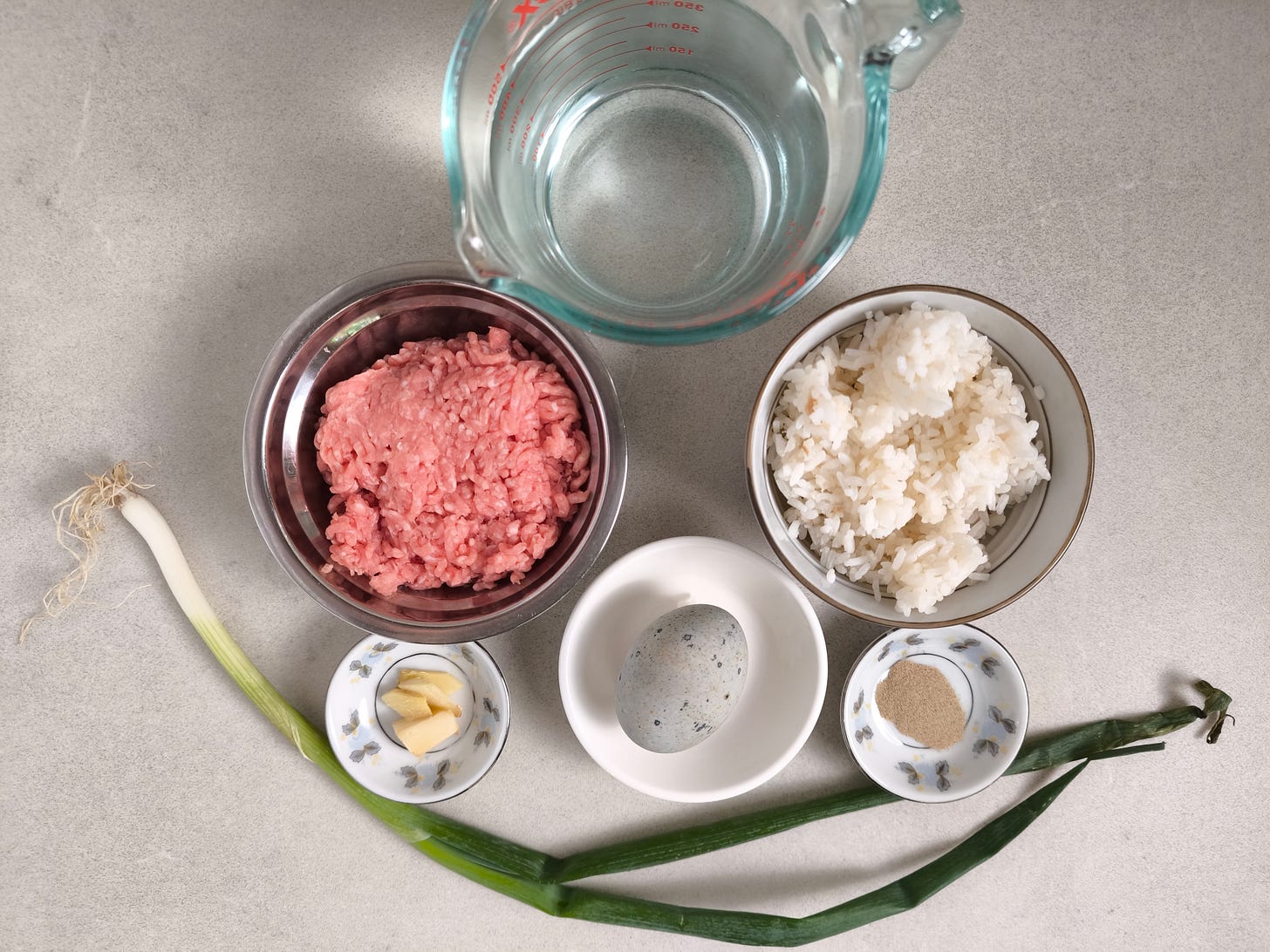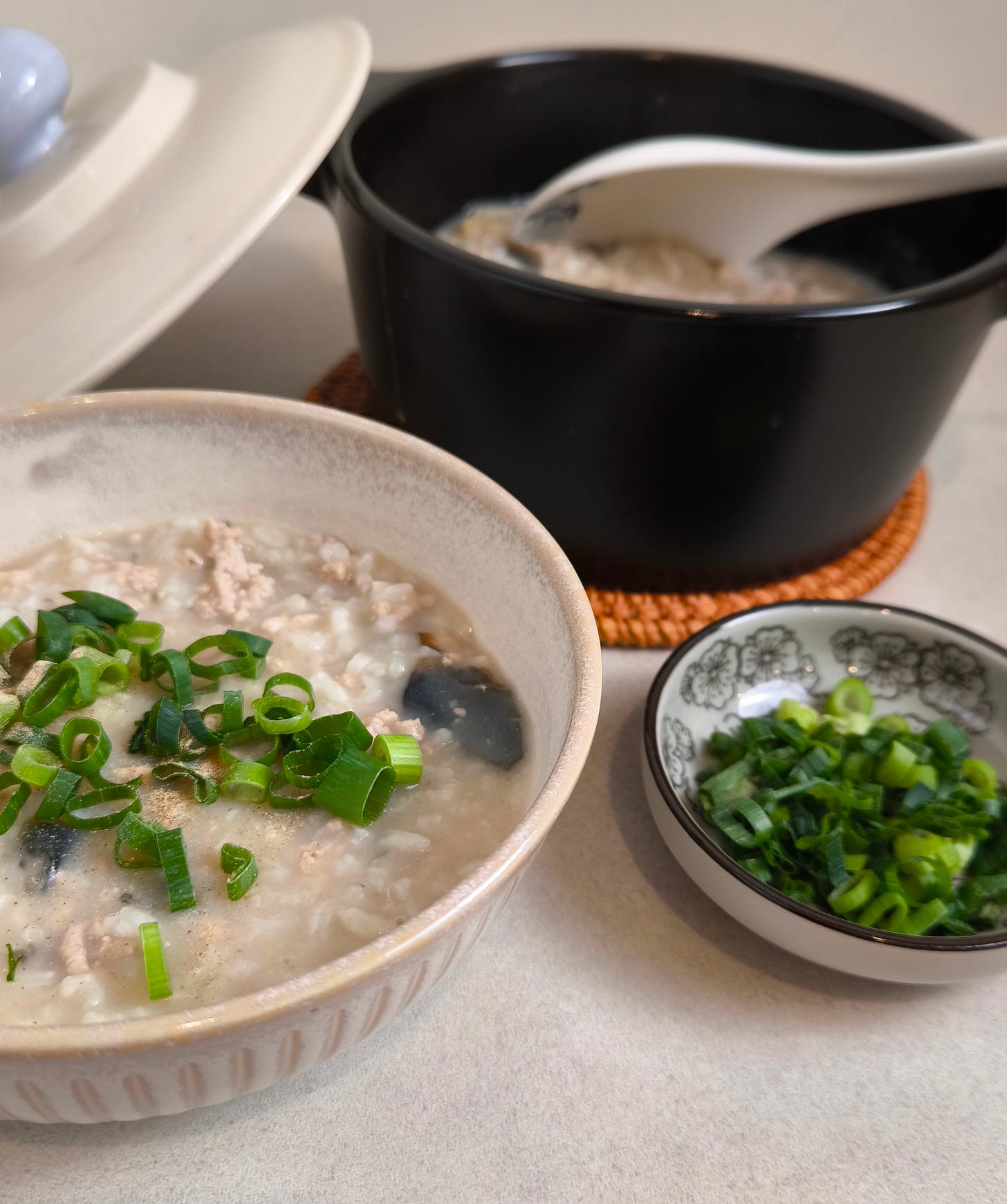*This is a free post*
Asian athletes - have you ever wondered if one of your childhood comfort meals could also help with sports performance the night before competition? While sports nutrition advice traditionally leans on Western staples like pasta, there’s a humble Chinese staple that deserves a spot on the table too: congee - the rice porridge that you grew up eating for breakfast. With a few tweaks, congee can become your go-to meal for every stage of training and competition.
At its simplest, congee is made from white rice and water. The rice is cooked down slowly until the grains are soft and transformed into a thick porridge. Itʼs a breakfast staple for many Chinese families.
Ingredients (serves 2)
Cooking time: 40–45 mins
1 preserved duck egg, peeled and roughly chopped
2 bowls leftover white rice* (approx. 250–300g)
1L water, plus more as needed
0.5–1cm piece ginger, peeled and sliced
200g pork mince
White pepper, pinch to taste
Spring onions, for garnish
Soy sauce or salt, to taste (optional)
Gently mix pork mince in a bowl so it mostly stays clumped.
Bring 1L water to a boil in a pot (or boil water in a kettle). Add the pork mince and let it come back to a boil. Once boiling, reduce heat, then remove the pork with a slotted spoon and set aside.
Skim off any scum with a spoon to leave behind a clear broth. Add rice, ginger, and preserved duck egg. Bring to a boil over medium heat, stirring occasionally so the rice doesn’t stick.
Continue boiling (don’t simmer) for 25–30 minutes, stirring occasionally. Watch the water level - if the congee is too thick and rice grains aren’t broken down yet, add more water, ¼ cup at a time and stir.
Once the rice is soft and the congee’s consistency** is to your liking, return the pork to the pot, breaking it up as you go and ensure it is cooked through.
Taste and season with soy sauce or salt if desired.
Ladle into bowls, top with white pepper and spring onions, and enjoy.
Cooking notes:
*Use leftover rice to save on cooking time. Cooking time will vary depending on the type of white rice grain you use - I use a medium grain Calrose rice but use whatever you like.
**Everyone’s preferred consistency of congee varies - I personally like mine thicker with the rice grains partially broken down. If you prefer yours thinner with fully broken down rice grains, cook it longer and add more water. Congee is flexible so it’s hard to stuff it up (unless you don’t watch it and it dries out and it burns the pot!)
Congee’s performance benefits
Easily digestible carbohydrates for quick supply of energy
Gentle on the stomach (great for pre-competition nerves!)
Customisable - add your preferred protein choice, and vegetables on the side for micronutrients
Versatile for meal timing (pre- or post-training)
How does congee fit in as a performance meal?
Pre-training fuel: Quick supply of energy and gentle on the stomach
Congee is an excellent pre-training meal when you need a supply of carbohydrates for the muscle and brain. Its quick digesting nature means minimal GI discomfort. For early morning sessions (e.g. 6am) where you may only have an hour or less to digest food, opt for plain congee without any protein additions as this slows down the digestion. For sessions that are later in the day and the body has more time to digest, adding preserved duck egg and pork is fine.
Refuel and Repair: Congee for Post-training recovery
After training, our body’s carbohydrate reserves (glycogen) have been partially used up, or in some cases, depleted if it lasted over 90 minutes. Just like your phone battery when you’ve been watching Youtube for 5 hours straight! Your muscles also need some TLC to prevent soreness the next day. Congee supplies both carbohydrates to refill your energy reserves, and protein for muscle repair. The great thing about a home-cooked congee is you can increase the protein content (aim for minimum 20g post-training). You’ll get ~25g protein per serve from my recipe.
Congee for carbohydrate-loading before endurance events
For the rowers, marathon runners, triathletes, open-water swimmers and road cyclists who need to carbohydrate load, reaching a carbohydrate goal of 8-10g per kg body weight 1-2 days prior to racing takes some planning. Here’s where congee comes in as one of your high-carbohydrate meals. Opt for a large bowl of congee with a small amount of protein additions to maximise carbohydrate intake. Its gentle nature means less stomach discomfort when you need to eat such large amounts of carbohydrate. I’ll explore carbohydrate-loading for Asian athletes in detail in a future post.
A great meal the night before competition
On the night before competition, a meal that’s high-carbohydrate and easy to digest will ensure your body’s energy reserves are full. This is important if you have multiple games, matches or races the next day. It’s like charging your phone for the next day. Preserved duck egg and pork congee is perfect the night before competition, just like spaghetti bolognaise.
Practical tips
Make a big pot for the week: Congee is very suited for preparing in bulk and reheating. This is perfect if you’re time-poor with a busy training and work schedule.
Balance your meal: Serve the congee alongside a plate of stir fried vegetables. This delivers micronutrients and supports immunity to minimise illness during intense training blocks. Don’t skimp on the vegetables!
On-the-go: Invest in a thermos as this helps to keep the congee warm for several hours - handy if you don’t have access to a microwave.
My preserved duck egg and pork congee is super versatile for supporting performance. So the next time you’re looking for a familiar Asian meal that brings back childhood memories to fuel performance, look no further than a bowl of congee.








